 SNOW HYDROLOGY (GEOG 4321): SKIING AT THE TRIPLE POINT
SNOW HYDROLOGY (GEOG 4321): SKIING AT THE TRIPLE POINT SNOW HYDROLOGY (GEOG 4321): SKIING AT THE TRIPLE POINT
SNOW HYDROLOGY (GEOG 4321): SKIING AT THE TRIPLE POINTSome suggested web sites
SKIING is the world's oldest sport. The post-glacial Stone Age people of the northern latitudes in Europe and Russia used skis-not made for speed but to keep hunters on top of the snow-to survive harsh winters. The first practitioners were probably the migratory Sami of what is now northern Norway, Sweden, and Finland, living very near the Arctic circle. Skis gave them greater mobility for hunting reindeer.
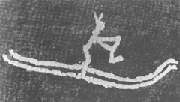 The Rodoy rock carvings of a hunter on runners,
4500 years old, are above the Arctic Circle in Norway.
The oldest ski, found in Sweden, is 5000 years old.
Scandinavia's peat bogs contain many ski artifacts, and the Viking "Sagas" described kings as
skiers.
The ski technology of the Sami was likely passed southward to the Vikings through occasional contact
and further developed throughout Scandinavia.
It may be little bold to say that Norway gave skiing to
the world. However, the word "ski" is definitely from the old norse language (from skith a stick of
wood).
The Rodoy rock carvings of a hunter on runners,
4500 years old, are above the Arctic Circle in Norway.
The oldest ski, found in Sweden, is 5000 years old.
Scandinavia's peat bogs contain many ski artifacts, and the Viking "Sagas" described kings as
skiers.
The ski technology of the Sami was likely passed southward to the Vikings through occasional contact
and further developed throughout Scandinavia.
It may be little bold to say that Norway gave skiing to
the world. However, the word "ski" is definitely from the old norse language (from skith a stick of
wood).
Norway's first "King", Olav I, (better known as Olav Tryggvason - around 995 AD) was described as a fine sportsman both on land and on the sea. "Han løper bedre på ski enn andre menn" wrote historians of the day. Historians also tells us that skiing was one of the eight "arts" that another Viking king, Harold Hardråde, mastered. Of course, others around the kings were also good skiers and occasionally there were competitions that resulted. One famous race pitted King Harold against a young unknown named Heming. King Harold thought that nobody could match him on skis, and went so far as to proclaim that thought quite publicly. So perhaps it was one of sport's early "upset" victories in the making when Harold the King found himself matched stride for stride by Heming the Young. Legend has it that the youngster won.
One particular race with death and the future of an entire country at stake occurred in the year 1206 and still lives prominently in the modern XC ski culture. Two of king Håkon of Norway's birkebeinerne, Torstein Skjeva and Skjevald Skrukka, were charged with the bloody serious task of skiing and/or fighting their way from Lillehammer to Østredalen while carrying the two-year-old son of the king, Håkon Håkonsson. King Håkon was attempting to unify Norway, and not everyone wanted to go along, especially other tribal leaders of the time. For these other would-be "kings", killing Håkon's son and breaking the lineage was a major goal. The two gaunt and poorly clothed skiers ("birkebeiner" translates to bark legs, for the strips of wood bark that were used to help keep their lower legs warm) could not have known how important their tiny cargo would become. Thanks to their heroic efforts, the boy lived to become a king that expanded Norway's boundaries beyond what they had ever been, or would be again.
Today, this famous flight for survival lives on as the Norwegian "Birkebeiner", a popular 58 km "touring" race over the same trek that the two made in 1206 (along with American and Canadian races by the same name). Now competitors are required to carry a 5kg backpack as a memorial to the burden carried during that first "race". Food, drink, and first aid is available from well-wishers along the course. Not quite the same as 800 years ago!
As early as 1767, descriptions were written of "professional" skiing competitions in Norway. Many of the participants were members of the military who were part of the "ski-company". These competitions were not limited to what is today called Cross Country, but also included "skiskyting" (biathlon), and downhill racing. The winner's premium was sufficient to pay for a horse and two cows, so the competitions were fierce! Looking back 100 years or so, it is important to realize that the extreme specialization that we see today within skiing was not always present. Heck, before 1850, skiers didn't even use 2 ski-poles, just one, long multi-purpose staff. In the past, ski-jumping, "downhill" racing and cross country were all practiced and contested by the same skiers. In fact, athletes generally performed all three disciplines on the same pair of skis! Today, that "all-around" ability survives as a foundation of the approach to teaching skiing to children in Norway. Small children use one pair of skis for all disciplines, and learn to jump, skate, slalom, etc. Ski poles are considered optional equipment! Only later does specialization take place. (adapted primarily from Stephen Seiler's web page at http://home.hia.no/~stephens/skihis.htm).
Sondre Nordheim of Morgedal, Telemark, Norway is often credited as the father of modern skiing. In 1850 he discovered the perfect heel strap, cleverly entwined shoots of the birch tree root, with enough stiffness to provide sufficient control of the ski to steer it and enough elasticity to stay snugly around the heel to keep the toe in the toestrap even going off a jump, making possible both modern downhill and ski-jumping. In a competition conducted by the Centralforeigning, or Central Ski Association in the Norwegian capital Christiania (now called Oslo)in 1866, Sondre Norheim and his fellow Telemarkers demonstrated what is later called the telemark turn and the Christiania skidded stop turn. In 1870 he introduced the first modern sidecut ski, the "Telemark ski," setting the basic pattern followed for a century thereafter, producing a narrow-waisted ski that flexed more readily when edged, facilitating turns in soft snow.
Snowshoe Thompson: "Viking of the Sierra" When John A. Thompson responded to an ad in the Sacramento Union : "People Lost to the World; Uncle Sam Needs a Mail Carrier", he had no idea he was to become a living legend. From 1856 to 1876 he made legendary 90 mile treks over snowdrifts up to 50 feet high and through blizzards with up to 80 mile per hour winds, to deliver mail to those living in isolation. He was the sole link between California and the Atlantic states during the long winter months.
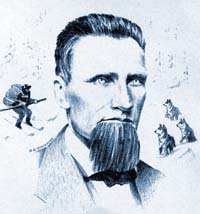 At the age of 10, Jon Torsteinson-Rue (later changed to John A. Thompson) came to America with
his family from Norway, settling on a farm in Illinois. The family moved on to Missouri then Iowa,
and eventually Jon went to stay with his brother in Wisconsin. Then gold fever struck.
At the age of 10, Jon Torsteinson-Rue (later changed to John A. Thompson) came to America with
his family from Norway, settling on a farm in Illinois. The family moved on to Missouri then Iowa,
and eventually Jon went to stay with his brother in Wisconsin. Then gold fever struck.
In 1851 at the age of 24 Thompson drove a herd of milk cows to California and settled in Placerville. For a short while he mined in Kelsey Diggins, Coon Hollow and Georgetown. With the small amount he saved, he bought a small ranch at Putah Creek, in the Sacramento Valley.
All attempts by postmen to cross the Sierra on woven Canadian and Native American snowshoes had failed until one day in late 1855, Thompson saw an ad in the Sacramento Union : "People Lost to the World; Uncle Sam Needs a Mail Carrier." He had had personal experience with mail deprivation, having once received long delayed news of a flu epidemic which claimed his mother's life, and quickly applied for the job.
As a young child in the Telemark region of Norway, ski shaped snow-shoes (called ski-skates) were as common as ordinary shoes. A crowd formed in Placerville for his first mail run in January, 1856. Few had faith that he would make it over the 7,500 foot passes on his homemade 10 foot long, 25 pound oak skis. But one optimistic voice in the crowd called out: "Good luck, Snowshoe Thompson" and he set out to become a legendary postman and father of California skiing.
Two to four times a month for twenty winters, regardless of weather, Snowshoe Thompson set out at the appointed hour. His mail run took 3 days from Placerville to Mormon Station, Utah (Nevada's first town,later called Genoa when Nevada became a state), and two days on the return trip. The people of the pioneer settlement knew when to expect his arrival. Baking was left in the oven and abandoned meals grew cold. Everyone ran outdoors looking up to the top of Genoa Peak to watch as the tall blond norseman descended, streaks of snow flying in his wake.
Thompson always wore a Mackinaw jacket, a wide rimmed hat, and covered his face in charcoal to prevent snow blindness. He carried no blankets, but he did carry matches to start fires, and his bible. He snacked on dried sausage, jerked beef, crackers, and biscuits. When a storm kept him from proceeding he would find a flat rock, clear it of snow, and dance old Norwegian folk dances until it passed, then he would continue on his way. He rested but briefly, and usually only long enough for a crust to form back over the fresh snow, for easier passage.
Dan de Quille of the Virigina City Territorial Enterprise later wrote of Thompson: "He flew down the mountainside. He did not ride astride his pole or drag it to one side as was the practice of other snow-shoers, but held it horizontally before him after the manner of a tightrope walker. His appearance was graceful, swaying his balance pole to one side and the other in the manner that a soaring eagle dips its wings."
Grizzly bears, mountain lions and wolves roamed his path, but he carried no gun, not wanting to limit the weight of mail and much needed supplies. On one trip he came upon a pack of wolves feeding on a deer carcass. When they noticed him, they sat on their haunches and howled. Snowshoe kept his pace, expecting them to attack at any moment, and flew right by them. When he looked back, they had returned to their meal.
Much as his Viking ancestors had traveled upon unmarked waters, Snowshoe Thompson crossed the Sierra Mountains, whose landmarks were buried in the snow. He didn't use a compass, once stating in an interview : "There is no danger of getting lost in a narrow range of mountains like the Sierra, if a man has his wits about him." He could tell his direction by day, from the appearance of trees and rocks, the flow of the streams, animal tracks, and snowdrifts. By night, the formation of stars guided him.
Snowshoe Thompson often rescued prospectors caught in the snow, and would carry them out on the back of his skis as they held their arms around him. One well-known incident took place just before Christmas in 1856, when he found a trapper named James Sisson, who had been sheltering with half-frozen feet in a deserted cabin for 12 days, with no food or fire. Thompson chopped him some wood to stay warm and set out to Genoa for help. He had to carve skis and give lessons to the rescuers who had agreed to accompany him. Once back in Genoa, the doctor reported that Sisson's feet needed to be amputated, but he had no chloroform. Thompson set out once again to Placerville , but there was none to be found, so he continued on to Sacramento. In all he traveled 400 miles in 10 days, and saved Sisson's life.
His mail sack often weighed up to 100 pounds: carrying medicine, emergency supplies, clothing, books, tools, pots and pans. Once he brought in a pack of needles and a glass chimney for a kerosene lamp so a widow, Mrs. Franklin, could continue her winter sewing. For the local fiddler, Richard Cosser, he brought new strings. And for the news starved miners, he carried the type and newsprint for Nevada's first newspaper, the Territorial Enterprise, piece by piece. The first issue went to press December 18, 1858.
In 1859 Thompson was asked to take a strange blue rock, which seemed to be devaluing the Washoe miners' gold dust, to Sacramento to have it assayed - it was rich in silver. The Comstock Lode had now been discovered, signaling an end to the California Gold Rush and the glorious 49er era. A new stampede began, this time from west to east and Thompson was asked to expand his mail route to Virginia City, year round.
As legends of Snowshoe Thompson's feats spread through the isolated regions of the Sierra, others began making skis and racing down the hills. For a short time, during the building of the Central Pacific Railroad, he carried the mail from Cisco to Meadow Lake. During the winter of 1867-68, one of the most severe in history, 3,000 people were met with an unexpected storm and ended up wintering in at Meadow Lake City. Clarence M. Wooster wrote in a letter that Thompson would "sail down his four-mile course at great speed, cross the ice frozen river, throw our mail toward the house, and glide out of sight, up and over a hill, by the momentum gathered in the three mile descent."
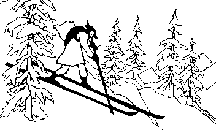 The Thompson's only child, Arthur Thomas, was born on February 11, 1867. His father could
hardly wait to take him snowshoeing, and made him a tiny pair of snowshoes for his first birthday. In
Alpine County, Thompson enjoyed teaching his neighbors how to make snowshoes, giving them
lessons and offering chilling demonstrations of his jumps at the top of Silver Mountain. Just as it
seemed he was going to run into the onlookers midway down the slope, he would spring up again,
flying right over them with a wide smile on his face. In one of his races, he skied 1600 feet in 21
seconds (55 miles per hour), and his greatest jump was known to be 180 feet, in the early 1870's!
The Thompson's only child, Arthur Thomas, was born on February 11, 1867. His father could
hardly wait to take him snowshoeing, and made him a tiny pair of snowshoes for his first birthday. In
Alpine County, Thompson enjoyed teaching his neighbors how to make snowshoes, giving them
lessons and offering chilling demonstrations of his jumps at the top of Silver Mountain. Just as it
seemed he was going to run into the onlookers midway down the slope, he would spring up again,
flying right over them with a wide smile on his face. In one of his races, he skied 1600 feet in 21
seconds (55 miles per hour), and his greatest jump was known to be 180 feet, in the early 1870's!
From 1868 to 1872 Thompson served on the Board of Supervisors of Alpine County, and was a delegate to the Republican State Convention in Sacramento in 1871. In spite of a resolution sent to Washington, D.C. by the Nevada Legislature, the many political contacts he had gathered, and a trip to Washington, D.C. in 1872, Snowshoe Thompson was never paid for his services delivering the United States Mail.
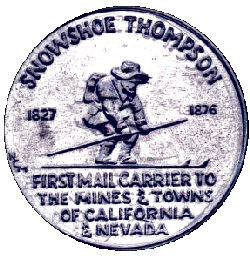 Snowshoe Thompson died of appendicitis which developed into pneumonia on
May 15, 1876. His son, Arthur, died two years later of diphtheria, and was buried
next to his father at the cemetery in Genoa. Agnes remarried in 1884, but the
following year had a snow-white marble erected on Snowshoe's grave, engraved
with a pair of crossed skis and the memento "Gone but not forgotten."
Snowshoe Thompson died of appendicitis which developed into pneumonia on
May 15, 1876. His son, Arthur, died two years later of diphtheria, and was buried
next to his father at the cemetery in Genoa. Agnes remarried in 1884, but the
following year had a snow-white marble erected on Snowshoe's grave, engraved
with a pair of crossed skis and the memento "Gone but not forgotten."
The Genoa postmaster S.A.Kinsey said: "Most remarkable man I ever knew, that Snowshoe Thompson. He must be made of iron. Besides, he never thinks of himself, but he'd give his last breath for anyone else - even a total stranger." The few times Thompson had thought of putting an end to his legendary Snowshoe Express, he continued just for the look on the faces of the people living in isolation. Hundreds of thousands from all parts of the globe emigrated to California in search of gold, but few left such a heartfelt mark on the Golden State's history as John A. "Snowshoe" Thompson.
Adapted primarily from Jill Beede at http://www.tahoecountry.com/oldtimetahoe/snowshoe.html. Additional information on Snowshoe Thompson.
The motion of a skier is a result of these primary forces:
acceleration = gravity - friction - air resistance
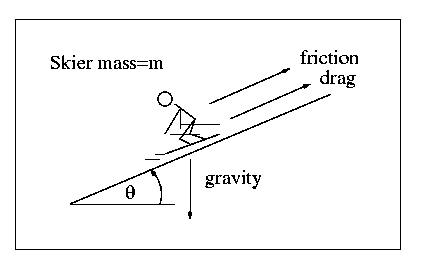
Gravity is a function of slope angle and the mass of the skier:

Skiers go faster:
Acting in the direction opposite to gravity is friction between the ski and the snow surface

Skiers go slower, and kinetic friction is greater, when:
Air resistance is also a big factor in determing the speed of a downhill skier:

Air resistance increases as:
Maximum velocity of a skier.
What is the maximum velocity that a skier can go?
At constant velocity, the situation becomes:
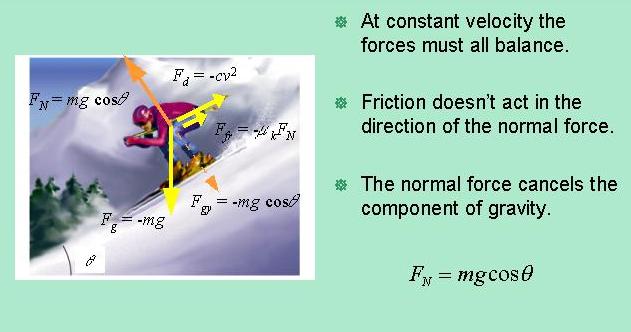
We can solve the equations above to obtain a range:
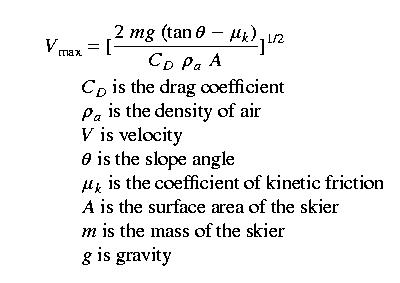
Now, let's plug in some reasonable values and see what we get:
Braking.
How much force does a ski turn generate?
The force of a turn is related to your velocity and the distance
of the turn or braking maneuver:

Let's put in some real values:
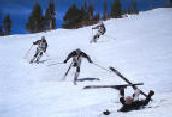
However, braking with your head is altogether different!
Let's look at friction a little closer. What do we know intuitively about the snow-ski system?
Skis (as well as ice skate, sleds and other such winter equipment) glide because, some what ironically, of their friction. The friction that does exist between the ski and snow melts a little snow to create a very thin film of water.

Schematic of a polished snow surface caused by repeated passes of a nordic ski.
Friction of a ski passage on the snow surface generates heat that causes localized melting of the snow surface. The thin film of meltwater refreezes once the ski contact stops. Essentially there is a small "meltwater cap" formed on the snow surface. This reduces friction and increases ski glide. This is one of the reasons that a nordic skier uses less energy behind someone breaking trail in fresh powder.

A capillary attachment. The water in this photography bridges between the base of a ski and a glass bead. Note the hysteresis in the contact angle due to the motion of the water over the dry ski. Colbeck, CRREL 92-2.
Too much meltwater slows the ski down because of capillary effects. Capillary drag comes from the surface tension of water. The picture above shows how water clings to the bottom of a ski and stretches. The water is exerting a slight force on both the marble and the ski. In snow, columns of water form in the airspaces between the snow crystals. These myriad columns act like the water droplet pictured above and pull on the ski. The wetter the snow is and the thicker the film of water is, then the stronger the capillary drag is.
Asperities, which are microscopic projections from the "average surface," play a major role in determining the coefficient of friction between materials. The surface of all materials is rough at the microscopic scale. These projections carry most of the load when two surfaces are in contact. The friction depends on the number and area of the asperities of the surfaces in contact. The pressure on an asperity is greater than the normal force, that it may deform the contact area "plastically" (asperities can weld together). Therefore, frictional resistance arises from sliding objects breaking and creating bonds created by asperities.

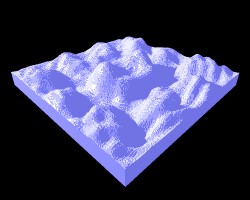

Ski surfaces are much smoother than the snow surface. Asperities on the snow surface carry most of the load when a ski passes over the snow surface. These asperities heat preferentially. The ice grain becomes smoother with repeated ski passes as ice melts on the summits or asperities of the grain and refreezes in the valleys. In a sense, the process is analogous to ET metamorphism.
Definition of friction. Let's get a little more formal about defining friction. Friction is typically characterized by a coefficient of friction which is the ratio of the frictional resistance force to the normal force which presses the surfaces together. Because it is a ratio, there are no units. In this case the normal force is the weight of the block. Typically there is a significant difference between the coefficients of static friction and kinetic friction.
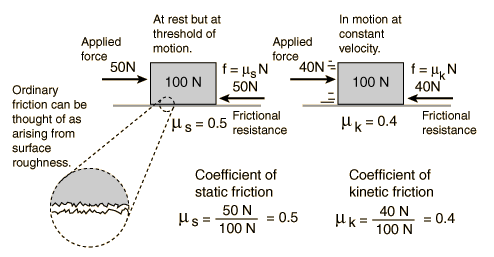
Note that the static friction coefficient does not characterize static friction in general, but represents the conditions at the threshold of motion only.
Static frictional forces from the interlocking of the irregularities of two surfaces will increase to prevent any relative motion up until some limit where motion occurs. It is that threshold of motion which is characterized by the coefficient of static friction. The coefficient of static friction is typically larger than the coefficient of kinetic friction.
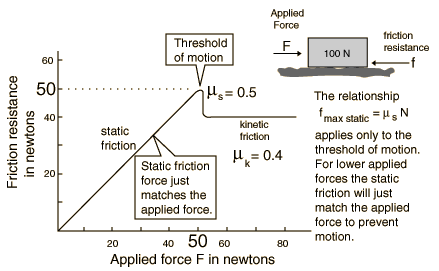
When two surfaces are moving with respect to one another, the frictional resistance is almost constant over a wide range of low speeds, and in the standard model of friction the frictional force is described by the relationship below. The coefficient is typically less than the coefficient of static friction, reflecting the common experience that it is easier to keep something in motion across a horizontal surface than to start it in motion from rest.
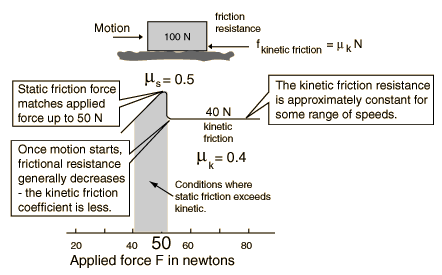
Much of this material is from the HyperPhysics site.
Following are some common values for the coefficient of friction.
|
|
Static µs | Kinetic µk |
| Teflon on Teflon | = .04 | = .04 |
| Rubber on Concrete (wet) | @ .30 | @ .25 |
| Rubber on Concrete (dry) | @ 1 | @ .8 |
| Steal on Steal | = .74 | = .57 |
| Metal on Metal (lubricated) | @ .15 | @ .06 |
| Human Joints (Synovial lubricant) | @ .01 | @ .003 |
| Ski Board (waxed on wet snow) | @ .14 | @ .1 |
| Ski Board (waxed on dry/power snow) | @ .14 | @ .04 |
| Ice on Ice | =.1 | = .03 |
| Wood on Wood (Rough) | @ .5 | @ .4 |
Note that the kinetic friction of skis on dry powder is much less than that for wet snow. The reason that kinetic friction is higher for wet snow is because capillary drag becomes more important with increasing liquid water content.
The amount of energy (q) generated by a skier can be calculated as:

Let's use some real values:
A downhill racer generates 200-300 W under each ski! About 80 watts is transferred to the snow underneath, melting the snow and creating a thin film of liquid that can reduce friction.
Does the color of skis matter? With black skis, the albedo is zero. If we assume incoming solar radiation of 600 W/m2 and a ski area of 0.16 m^2, q = 112 watts at the base of the ski. Black skis are a good thing on cold days because they efficiently generate a meltwater film. However, on warm days, they'll generate too much meltwater and cause capillary drag.
This energy generated by a ski passing over the snow is not transferred uniformly to the underlying snow surface. Most of the energy is concentrated on asperities, causing "flash heating". The solid to solid contact in the ski/snow system is about 1% of the ski area. The change in temperature for a dry ski passing over a snow surface can be calculated as:

The maximum temperature increase can be as high as 1,000 degrees C for asperities!, for a situation where the slider is 2 m in length, weight of 400 N, and a velocity of 10 m/s. Ice will definitely melt!.
However, it takes a while to generate enough heat to melt the ice. So, the front of the ski does not see this meltwater:

Warmer snow temperatures take a longer lenght of ski to generate a meltwater film, as does increasing surface area. In contrast, the faster you ski or the heavier you are, the less ski length it takes to generate a meltwater film.
Friction summary